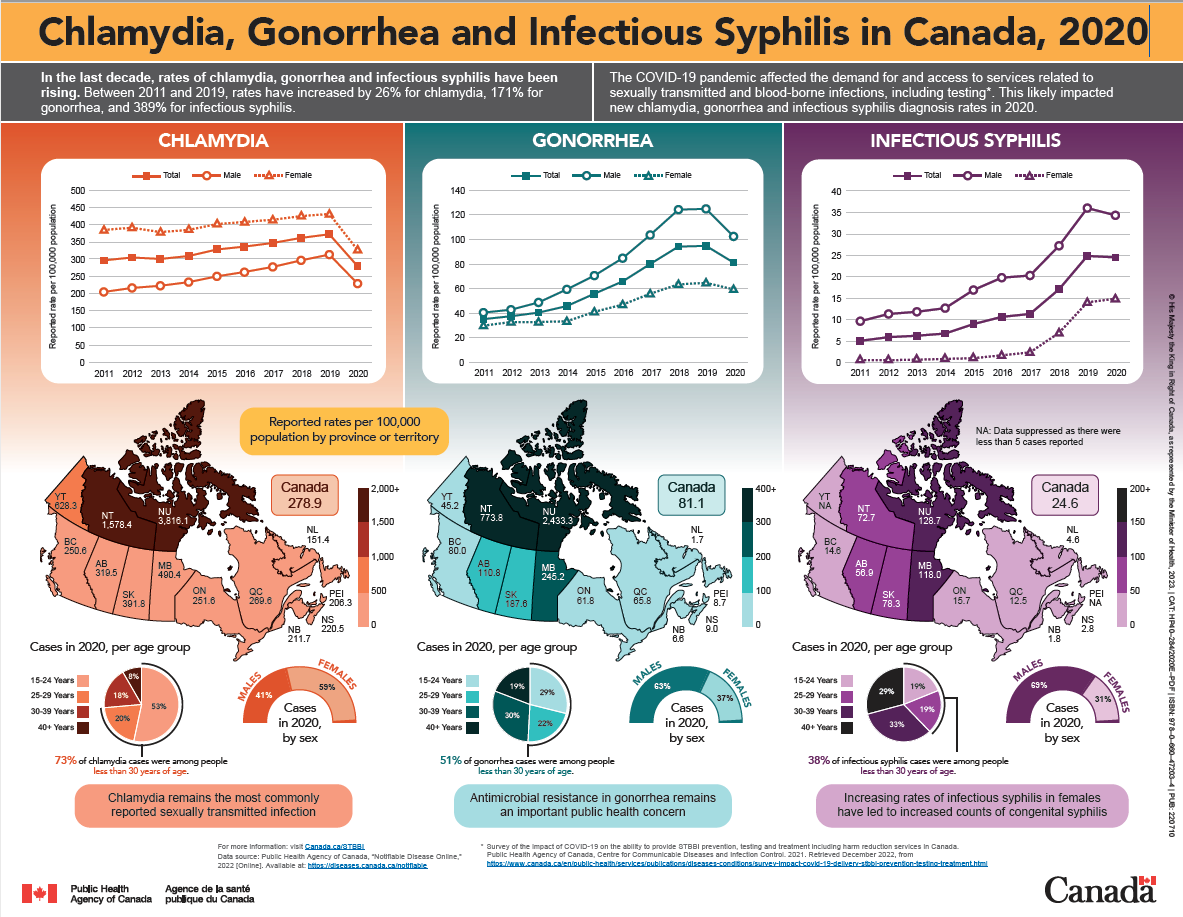STBBI Basics: STIs

Chlamydia
Chlamydia is a sexually transmitted infection (STI) caused by the bacterium Chylamdia trachomatis.
It is the most commonly reported STI in Canada and when left untreated, can lead to painful health issues and infertility.
Chlamydia rates have continued to climb since 1997, due in part to improved lab testing and screen, but also due to people not consistently using safer sex practices.
- Chlamydia is known as the “silent disease” because approximately 50% of males and 70% of females with the infection have zero symptoms and are unaware of their condition.
- It is diagnosed through a urine sample or by swabbing the infected area.
- Treatable with antibiotics.
- Symptoms of chlamydia for women may include vaginal discharge, burning sensation while urinating, lower abdomen pain, fever or chills, pain during sex, and/or vaginal bleeding between periods or after intercourse.
- Symptoms of chlamydia for men may include discharge from the penis, burning sensation while urinating, burning or itching sensation at the opening of the penis, and/or pain in the testicles.
- In both males and females, chlamydia can infect the rectum. Symptoms include rectal pain, bleeding, and discharge.
- 40% of women who leave chlamydia untreated will develop pelvic inflammatory disease, which may cause scarring of the fallopian tubes and potentially infertility.

Syphilis
Syphilis is a bacterial sexually transmitted infection (STI) that is becoming common in most provinces in Canada.12
Syphilis develops in stages: primary, secondary, latent and tertiary, with each stage presenting different symptom.13
- During the primary stage, a painless chancre (or sore) develops at the site in which the syphilis bacteria entered the body.14 Typically, within 10-90 days of exposure.14 For men the chancre usually will appear in the genital area, while for women, the chancre will usually develop either outside or inside the vagina.14
- The secondary stage is characterized by a rash which typically appears 2 to 8 weeks following the development of the chancre.14 The skin rash will usually heal within 2 months, however, the individual with syphilis is very contagious during the secondary stage and even after the rash heals, syphilis is still present, and the individual can still pass on the infection to others.14 Other symptoms may occur during this stage, meaning the infection is spreading through the body.14 These symptoms may consist of a fever less than 38C, a sore throat, body weakness, weight loss, patchy hair loss, headaches, irritability, paralysis, unequal reflexes, and irregular pupils.14
- If syphilis is left untreated, it will progress into what is known as the latent stage.14 This is also known as the hidden stage of syphilis.14 Following the secondary stage rash, the body will not show any symptoms for period ranging from 1-20 years.14 An accurate diagnosis during this stage can only be done through a blood test or birth of a child who has congenital syphilis.14 An individual remains contagious during the early period of the latent stage and is at risk of still transmitting the infection even when no symptoms are present.14
- 20%-30% of people with syphilis will experience a relapse of the secondary stage during the latent stage.14
- Finally, is the tertiary stage, which is the most harmful stage of syphilis.14 The tertiary stage may begin as early as one year after initially being infected or for some, they will never experience the tertiary stage of the illness.14 Complications related to the tertiary stage are Gummata (large sores inside the body or on the skin), Cardiovascular syphilis (affects the heart and the blood vessels), and Neurosyphilis (affects the brain and rest of the nervous system).14
- Alberta declared a syphilis outbreak in 2019 after 2265 cases reported that year and an additional 2500 cases being reported in 2500.15
- Syphilis can be treated with specific antibiotics.15
Gonorrhea
Gonorrhea is a bacterial sexually transmitted infection (STI) and is on the rise in Canada, making it increasingly resistant to antibiotics.17 In females, if left untreated, gonorrhea can lead to pelvic inflammatory disease, which increase the risk of abdominal pain, fever, internal abscesses, chronic pelvic pain, and the scarring of the fallopian tubes, which can cause infertility17. If left untreated in men, gonorrhea can cause epididymitis, which is a painful inflammation in the tubes attached to the testicles and can in rare cases can lead to infertility.17
- Commonly known as “the Clap”.17
- Gonorrhea can be transmitted from mother to child during birth.17
- Without treatment, gonorrhea can cause blindness in newborns.17
- Symptoms for women may include a burning sensation when urinating, vaginal discharge, lower abdomen pain, pain during sex, and vaginal bleeding after sex or between periods.17
- Females with mild or no symptoms are still at risk of serious health complications.17
- Symptoms for men may include a burning sensation when urinating, yellowish/white discharge from the penis, burning at the opening of the penis, painful or swollen testicles.17
- Several gonorrhea strains in Canada have become resistant to previously recommended treatment.17
- The gonorrhea bacteria cannot survive outside the body for very long.17
-
Chlamydia. Public Health Agency of Canada. Published June 29, 2021. Accessed August 4, 2022. https://www.canada.ca/en/public- health/services/diseases/chlamydia.html
-
Chlamydia. National Health Services. Published September 1, 2021. Accessed August 4, 2022. https://www.nhs.uk/conditions/chlamydia/
-
Syphilis Guide: Etiology and Epidemiology. Public Health Agency of Canada. Published July 7, 2022. Accessed August 4, 2022. https://www.canada.ca/en/public-health/services/infectious- diseases/sexual- health-sexually-transmitted-infections/canadian- guidelines/syphilis/etiology-epidemiology.html
-
Syphilis. BC Centre for Disease Control. Published 2022. Accessed August 4, 2022.
http://www.bccdc.ca/health-info/diseases-conditions/syphilis
-
Syphilis. Government of Alberta. Published February 11, 2021. Accessed August 4, 2022. https://myhealth.alberta.ca/Health/Pages/conditions.aspx?hwid=hw195071
15. Syphilis Outbreak. Alberta Health Services. Accessed August 4, 2022.
https://www.albertahealthservices.ca/info/Page17087.aspx
-
Sexually Transmitted Diseases. Centers for Disease Control and Prevention. Published February 10, 2022. Accessed August 4, 2022.
https://www.cdc.gov/std/syphilis/stdfact-syphilis.htm
17. Gonorrhea. Public Health Agency of Canada. Published July 18, 2022. Accessed August 5, 2022. https://www.canada.ca/en/public-health/services/diseases/gonorrhea.html
-
Gonorrhea. Centers for Disease Control and Prevention. Published April 12, 2022. Accessed August 5, 2022. https://www.cdc.gov/std/gonorrhea/stdfact-gonorrhea.htm
